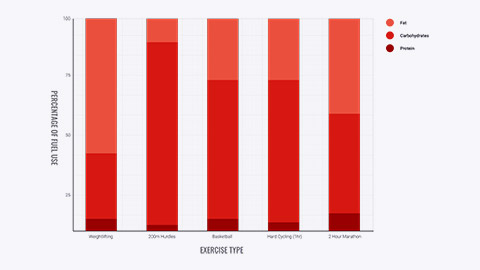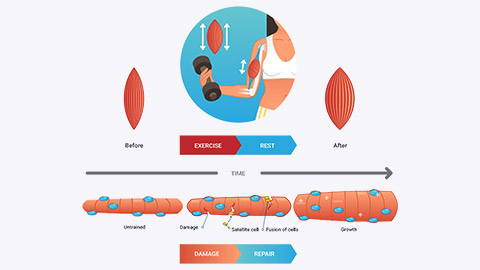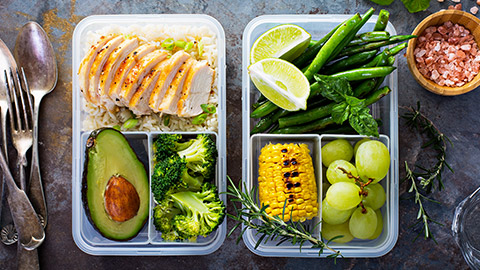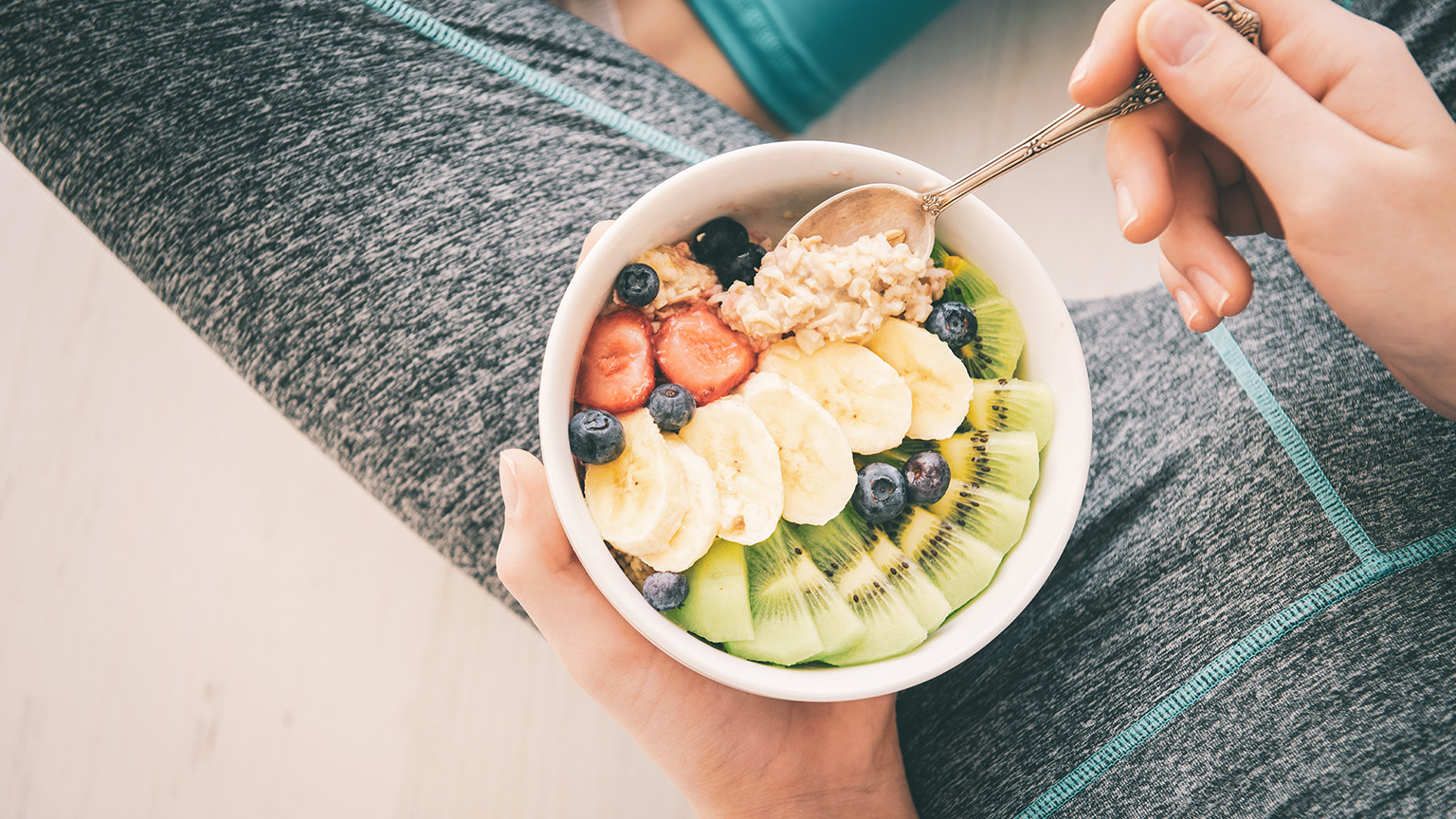Nutrition and physical activity
In this topic, we focus on the importance of nutrition and the impact of physical activity. You will learn:
- about using nutrition as fuel
- nutrition for training and refueling
- advantages of being fit
- practical application of nutrition and physical activity
Terminology and vocabulary reference guide
As an allied health professional, you need to be familiar with terms associated with nutritional principles and use the terms correctly (and confidently) with clients, your colleagues, and other allied health professionals. You will be introduced to many terms and definitions. Add any unfamiliar terms to your own vocabulary reference guide.
Activities
There are activities and an automated quiz at the end of this topic. These are not part of your assessment but will provide practical experience that will help you in your work and help you prepare for your formal assessment.

Nutrition provides the human body with nutrients for overall wellbeing. Food acts as the fuel that is utilised for energy throughout the day. When it comes to fuel, the body is like any other machine, it needs the appropriate fuel to function and carry out the task in hand. To gain top performance it is important to:
- give it the right fuel (adequate food sources)
- provide it with proper maintenance (keep it moving and get regular health check-ups)
- regularly test its physical capabilities (keep active and challenged with physical activities).
It is vital to consider what is necessary to maximise performance during an exercise. The following elements are key to remember:
- it is necessary for the body to have adequate food consumed for the activity being performed, ensuring there are optimal muscle glycogen and full liver glycogen stores to be used for energy through training.
- it is essential to stay hydrated throughout the day and physical activity
- it is imperative to regularly challenge the body through an exercise to prompt a change.
- ensure there is ample time for the body to rest and complete recovery of the worked-out muscles.
When working with clients and discussing nutritional aspects to support their training, it is important to have a solid grasp on the following:
- body type
- goals
- intensity & duration of exercise
- frequency
- nutrients available
With that in mind, let’s look further into eating for performance.
Fuel utilisation
Let’s begin by having a look at the individual fuel groups and the role they play in providing the body with the energy it requires. We will look at the three food classifications ( protein, fat and carbohydrates) and how they support the physiological functioning in relation to day-to-day activities and also when exercising, the role the play and the order upon which they are called upon to support the optimal functioning of the metabolic and cellular processes required.
Carbohydrates (CHO), fats and proteins all provide the body with energy for exercise. CHO and fat will provide the majority of energy, with protein taking on the role of a repair type fuel. The higher the intensity of the exercise, the greater the fuel supply made from CHO in order to meet the increased demands. Once carbohydrate levels run low, the body will then turn to other sources of fuel including fat but also protein.
Typically, their order of service is:
- Carbohydrate
- Fat
- Protein
Carbohydrate stores are of extreme importance to all athletes as this fuel source is the most readily available has the one which provides the greater quantity of energy (in terms of kJ ( kilojoules) per litre of oxygen consumed).
Fat is a huge energy reserve, so vast that it could be used to supply energy for moderate-intensity activity for several days. Fat, along with CHO, is typically the main energy source called upon during training. Fat is stored, not in the muscle but in the adipose tissue within the body, so whilst it serves as an abundant energy source, it is not readily available as it is located out with the muscle, therefore, the body is required to metabolise it into a transportable form and then transport it from the adipose cells and into the contracting muscle cells before it can be utilised as a fuel source.
Whilst the use of fat as a fuel source is desirable for many people, the use of protein in significant amounts is not. When an intense activity is performed with low glycogen stores, protein can contribute up to 15 percent of energy. Whilst this is useful to be aware of, it is hugely important to be aware that protein never plays the lead role in energy provision as even a small increase over the usual contribution can have deleterious effects over time.
The following diagram gives an approximation of the usage of the three different fuel sources during different exercise types and intensities.

Pre-exercise fuel
A common thought is that once carbohydrates run out while exercising, the body will naturally turn to fat as a fuel source. While there is truth to this statement, it is important to be aware that the fuel used is ultimately dependent upon what fuel is available in the system.
However, generally speaking, because our body already obtains plenty of fat, the pre-exercise meal doesn’t require to have much, if any, fat in it. This would mean that the fat used as energy is the fat that is already stored in the body. Being mindful that the body does not use much protein during exercise, there shouldn’t be a focus for this in the pre-exercise meal either (we will look more at protein in the post-exercise phase). This leaves carbohydrates as the first access to energy to be used by the body for exercise.
CHO (carbohydrates) should be the majority of the nutrients eaten in a pre-exercise meal. The amount and type of CHO will be dependent on the duration and intensity of the session to come (i.e. 30 min jog vs half marathon) and the time available before the session to digest and absorb the food (complex CHO vs simple CHO).
Fuel for muscle repair

Every time a muscle is used against a force, it causes damage in the form of micro-tears, this process is referred to as the ‘tear and repair theory’. In order for a muscle to grow, it is ‘damaged’ by training and then, during the healing process, it repairs to a bigger and stronger version than prior to training, the volume of repair is relative to the intensity of training performed. The body uses protein as a fuel source to repair the damage and build a little extra as protection against future stress (this can be seen physically as muscle growth).
If protein is being used up as a fuel source for other metabolic processes, there will be a risk of not having sufficient levels of protein available for damage repair let alone facilitate growth, and therefore, the damage will continue to occur.
Long-distance runners stress their muscles continuously, even long after their glycogen stores are depleted. Serious runners understand this and include high amounts of protein in their diets to try and off-set losses. It is important as an exercise professional that you are comfortable with the goals of the client and are able to guide them accordingly in terms of appropriate nutritional support.
Take a look at the following video which provides an engaging summary as to the process of muscle growth via the tear and repair theory and the role of protein.
Fuel for goals

A client’s personal goals can determine the types of macronutrients used as fuel throughout the day and prior to training. There may be a need to adjust the initial fuel requirements to adapt as their activity and performance improve as well as their personal goals that might change over time.
Let’s have a look below at some client goals and tips for fuel.
Performance
If the client has an exercise performance goal and wants to focus on building strength and endurance, step one is to ensure they always have adequate carbohydrates on board before training. A high-intensity exercise regimen cannot be performed effectively without carbohydrates (CHO), any training goal that has a performance element to it must include CHO in the pre-exercise window. By removing CHO this effectively ensures that performance is below average and a performance deficiency will become evident as soon as carbohydrate (CHO) depletion occurs, continuing to exercise will begin to feel tough and the results simply won't come, the loss of muscle through protein breakdown will lead to long term reductions in muscle performance, the absolute opposite as to the desired goal.
Glycogen, found only in the liver and the muscles, is the term given to the stored form of carbohydrates. It is a valuable fuel source for the body however, it is required to be converted into easily metabolised food in order to be used as an efficient energy fuel source.
Weight loss
In the case of a weight loss goal, moderate-intensity cardio with no CHO in the lead-up, will undoubtedly result in weight loss. However, this is only if the client can maintain the exercise for a suitable amount of time (upwards of 40mins) and work at an intensity that results in a sufficient amount of calorie expenditure to support their weight loss journey. This might be difficult without the extra power from CHO, by not allowing CHO beforehand the exercise will undoubtedly feel a lot tougher, and for a population group who already struggles with exercise, they would be less likely to stick with the exercise regime. Typically, under these conditions, if they do stick with it, a good portion of the weight they lose will be muscle which is not ideal.
Weight Loss and Performance
Many clients will have goals of both weight loss and performance. These clients will need to manipulate their diet by eating like a weight loss client away from exercise and then ensuring they have enough CHO availability around the time of training. Important, before reducing CHO intake with a client, be sure to revisit their goals and amount of physical exercise performed to ensure careful dietary planning to help your client to achieve their weight loss and performance goals.

Pre-workout fuel
The pre-workout meal is all about fuelling up to prepare the body with sufficient energy in preparation for the upcoming training activity. What and how much is eaten in this meal depends largely on how much time each individual has available for digestion and absorption, their body size, their goals and the duration and intensity of the exercise session.
Let’s look at the types of macronutrients that can be used within a pre-workout meal to appropriately prepare the body for training.
Carbohydrates
If the exercise session is to be done at any meaningful intensity you must fill up muscle and liver glycogen stores that are gained through the consumption of carbohydrates.
100-200g of mainly complex carbohydrates in the 4 hours prior to exercise is recommended, this number depends however, on body size and duration of the activity.
The meal should typically be a complex carbohydrate-based meal as this will ensure a gradual release of glucose, and avoid an immediate and rapid insulin response, allowing enough time for the food to clear the gut and reach the liver and muscles is critical.
It is important to consider the time frame of when to eat a pre-workout meal, if the meal is consumed too extremely or too many hours prior to an exercise (e.g. 6 hours) the body will start chewing through glycogen reserves before exercise begins. Alternatively, if the meal is consumed too close to a workout activity, the food would not have enough time to have cleared the gut before the training resulting in the fuel not yet being be available for the muscles when performing the exercise and will likely cause discomfort (stitch) and possibly the feeling of nausea. As it gets closer to the time of exercise, or if there is a fast turnaround between exercise bouts, stick to moderate/high GI carbohydrates to ensure they clear the gut quickly, if it is within an hour of exercise, it may be best to stick to liquid forms (e.g. up and go, sports drinks etc).
See an example of how to fuel with CHO pre-workout below.
Breakfast: 7 am
- 1 cup of oats with trim milk and a medium banana (85g). 2 pieces of wholegrain toast with jam (45g).
Snack: 9 am (allowing 2 hours for digestion)
- pottle of yoghurt, an apple and a muesli bar (50-60g)
Training: 11 am
TIPS
Be practical. If the exercise performed is early in the morning, most people will not have much of an appetite and may only feel like a small snack. In this case, adjust the consumption of carbohydrates to include them in the meal the night before and prior to the workout, a quick-absorbing carbohydrate snack (at least 50g) in a liquid form is best, for instance, a low-fat smoothie, a banana or a juice. Also, consider the length of the session, if it is a light jog for 30 mins, a small snack will be fine.
Protein
Protein does not need to play a major role in the pre-exercise meal as it is not one of the main fuels used during training. This is mainly due to protein acting as more of a ‘repair fuel’ rather than an ‘energy fuel’ and, as protein is very satiating (filling), including protein in a pre-exercise meal may prevent eating the required amount of carbohydrates needed to perform well for the whole session, therefor, when discussing protein intake, try and keep protein levels from getting too high in the pre-event meal.
Fat
Aim to keep fat to a minimum in the pre-exercise eating window. While fat is a desirable fuel to use during aerobic exercise, we generally have plenty stored, so there is little to no need to worry about loading up prior to exercise, as it is extremely unlikely the body will run out of internal fat stores during a single bout of exercise, regardless of how low the body fat percentage. Fat also slows the absorption rates of other nutrients ( sometimes we need this, sometimes we don’t) which may interfere with the fuel storage process for carbohydrates. Be mindful that both fat and fibrous foods before an exercise may cause gastrointestinal discomfort.
FUN FACT
An average size 10 woman would have around 100,000 calories of stored body fat. Given that a woman of that size would burn around 2300 cal during a marathon, she could theoretically fuel 43 marathons off her stored body fat. This illustrates why there is no need to include fat in a pre-workout feed.

Fuel during an exercise
At times, re-fuelling during exercise may be required, typically this is only necessary when training/competing continuously for over 75 minutes. Carbohydrates should be ingested at a rate of 30-60g/hour for every hour after the first 75 mins. Initially, this could be in the form of a mouth rinse or gel, but in subsequent hours (during long events) solid food may be tolerated by some athletes. Regardless of whether liquid or solid, these should be simple carbohydrates (sports drinks are often the best option for providing fluid as well as nutrients). Half a bottle of Powerade provides nearly 30g of CHO and electrolytes to replace sodium lost in sweat. Food with moderate to high GI will ensure glucose clears the gut and gets to working muscles quickly, this also helps avoid stomach discomfort (stitch).
Fuel post-workout
Straight after a workout is a vital time to replenish muscle stores of glycogen and aid repair and regeneration of tissue broken down in training- hello protein! It helps to have these meals organised in advance as hunger can come on quickly after a workout and if this isn’t previously planned, it can lead to poor food choices. Let’s take a look below at the 3 different fuel types and their recommended intake post-workout.
Carbohydrates
It is suggested to have approximately 1-1.2g/kg of carbohydrate within approximately 30-60 minutes post-exercise completion. If more activity is planned later in the day, this can be followed with carbohydrate snacks/meals throughout the rest of the day. Any GI is ok (this is a window for high GI carbohydrate). e.g. A 65kg woman would need to eat around 65-70g of carbohydrate within 30-60 mins of exercise completion (e.g. a smoothie with 200ml of flavoured yoghurt, 400ml trim milk, a banana and small handful of berries). If exercise is completed late in the day/evening, some athletes will forgo large intakes of carbohydrate, particularly if there is plenty of time to restore glycogen stores before the next day work out, however, this is not recommended if an early bout of exercise is planned the next day.
Protein
Some protein should be included in post-training meals, this can help to restore muscle glycogen levels, repair muscle tissue and may help encourage gains in lean body mass. 20-30g in post-event meals (100g of lean meat yields between 25-30g of protein). There is no evidence that eating more protein equates to more muscle mass, as with many aspects of physiology, the body will only take on what is can use or store, the rest is simply removed from the body. In terms of convenience, protein supplements such as whey protein shakes may be easiest to consume post-training. When consumed alongside simple carbohydrates, the carbohydrates and protein will enter the muscle together facilitating better muscle glycogen replenishment.
Fat
Fat has a slow absorption rate and will slow the absorption of other nutrients such as carbohydrates and protein. The human body already has plenty of fat stored within, so there is no necessity to refuel with fat. Generally, athletes should keep fat intakes to a minimum (especially around training). Fat is not recommended within 2 hours prior to, or after exercise.

Fitness levels can contribute to the overall results achieved by an individual. The fitter a person is, the greater the rate of fat being used as a fuel source. Let’s look at a comparison of the impact of fuel and fitness between these two types of individuals.
Fit
A fit persons’ body becomes accustomed to the regular needs of fuel needed to keep their body going. For instance, when a fit person goes for a run, their body knows (from previous training) that they will be running for a certain duration. The clever body will then, at a certain point in training, start to utilise fat in an effort to preserve carbohydrate stores to support the usual fitness activity performed. Therefore, for this person, carbohydrates and fats are used together to fuel aerobic activity. Additionally, a fit person has an improved cardiovascular ability and thus greater blood flow, that will further aid the delivery of far more oxygen to working muscles to support higher intensities while still utilising the aerobic energy system ( compared to their unfit counterparts) and therefore continue to be able to use fat as a fuel source.
Unfit
Unlike the fit individual, if this person starts to run, their body is ill-prepared to deal with this. The body doesn't know the plan is to run for a period of time (as this is not yet a regular occurrence), so the body simply uses carbohydrates as it's primary fuel source (even at moderate intensities). This shows the importance of regular exercise as in this scenario, carbohydrate stores run out quickly and fatigue sets in after a shorter period of time.
A great way for an unfit person to teach their body to use more fat as a fuel source during exercise is to start a regular (daily) steady state aerobic exercise regime. Over a number of sessions, the body will then learn to better access fat stores to try and preserve carbohydrate stores.

Protein and carbohydrates, being the main source of fuel, provides nutrition to support performance during and recovery after an exercise. Let’s take a look at all the types of food that are acceptable to eat before training to be used as fuel, and after training to assist with repair and recovery.
Pre-exercise foods
It has been suggested that low GI carbohydrates are most beneficial to consume in the hours prior to exercise (approximately 2-4 hours prior). There are significant benefits to low GI carbohydrate consumption during this time due to the greater glycogen storage from the gradual release of blood glucose, however, it is important to be aware that many low GI foods are also rich in fibre, and fibre can cause stomach discomfort in the lead up to the activity. What athletes can tolerate in the lead up to exercise is highly individual and should be practised in training before trying out in the competition.
Let’s take a look below at some acceptable foods prior to training- it is important to note that some would not be considered to be low GI. Additionally, be aware that the carbohydrates in the list are paired up with small amounts of protein to ensure the total of CHO delivery is high and the absorption is somewhat slow.
The following foods are suitable to eat 3-4 hours before exercise:
- crumpets or multi-grain toast with jam or honey
- baked potato + cottage cheese filling + glass of milk
- smoothie with fresh fruit, yoghurt and oats.
- baked beans on toast
- breakfast cereal with milk (oats, weet-bix)
- bread roll with meat/salad filling + banana
- fruit salad with fruit-flavoured yoghurt
- pasta or rice with a sauce based on low-fat ingredients (e.g. tomato, vegetables, lean meat)
The following snacks are suitable to eat 1-2 hours before exercise:
- liquid meal supplement, Up & Go etc
- flavoured milk or fruit smoothie
- sports bars/muesli bars (those with high carbohydrate and limited protein and fat)
- breakfast cereal with milk (cornflakes, Nutri-grain etc)
- fruit-flavoured yoghurt
- fruit (all, but especially bananas)
The following foods are suitable to eat if there is less than 1 hour before exercise and it is advised for this food to be consumed for energy usage during a long event:
- sports drink
- carbohydrate gel
- cordial
- sports bars
- jelly lollies
FUN FACT
The Glycaemic Index (GI) of foods should get higher the closer it gets to exercise, this is because higher GI food clears the gut quickly, avoiding having undigested food sitting in our stomach as the activity starts. Having it in liquid/gel form further is also an option.
Recovery Nutrition
The focus of post-exercise nutrition is multi-dimensional. The overall target being:
- replenish muscle and liver glycogen (carbohydrate) stores
- replace fluid and electrolytes lost in sweat (weighing before and after training will help establish required volume),
- enhance repair and synthesis of muscle, red blood cells and other cellular components as part of the repair and to support the immune system in handling the damage and challenges caused by the exercise bout.
A proactive recovery means providing the body with all the nutrients it needs, in a speedy and practical manner, to optimise the desired processes following each session. The quantity and makeup of food/fluid consumed will be determined by:
- The amount of fuel utilised.
- The extent of muscle damage and sweat losses incurred.
- Whether enough stimulus was presented to increase muscle protein needs (i.e. amount of exercise-induced micro-damage).
Let’s look at the impact of nutrients for recovery after training and some food examples.
Carbohydrates
In the immediate post-exercise period, athletes are encouraged to consume a carbohydrate rich snack or meal that provides approximately 1-1.2 g of carbohydrate per kg body weight, this is advised to occur within the first hour of finishing (as this is when rates of glycogen synthesis are greatest). What type of meal or snack suitable for consumption will depend on a number of factors, including the athletes' daily carbohydrate allowance, how well they can tolerate food post-event and the time before the next training session.
See the below example of suitable carbohydrates for recovery.
Carbohydrate-rich recovery snacks suitable to eat within 1-hour post-training (50g CHO portions)
- 700-800ml sports drink
- 2 sports gels
- 500ml fruit juice or soft drink
- 300g of creamed rice
- 2 slices toast/bread with jam or honey or banana topping
- 2 cereal bars
- 115g (1 large or 2 small) fruit breakfast muffins, fruit buns or scones
- 300g (large) baked potato with salsa filling
- 100g pancakes + 30g syrup
- "Banana dog" - 1 large banana wrapped in white bread.
Protein
Resistance and endurance athletes will benefit from consuming approximately 15-25g of high-quality protein in the first hour after exercise to promote an increase in muscle repair/rebuilding. Consuming food sources of protein in meals and snacks after this “window of opportunity” will further promote protein synthesis, though the rate at which repair/rebuilding occurs is far less! Adding a source of carbohydrate to this post-exercise snack will further enhance the training adaptation by reducing the degree of muscle protein breakdown. See the suitable proteins needed for recovery, be mindful of the total includes the addition of CHO for an enhanced training adaption.
Protein snacks suitable to eat within 1-hour post-training (total of 50g CHO + protein)
- Up & Go Energise
- 300g creamed rice
- 250-300ml milk shake or fruit smoothie
- large glass of low-fat flavoured milk
- 1-2 sports bars (check labels for carbohydrate and protein content)
- 4-5 weet-bix with milk (or large bowl of other low-fat cereal).
- 1 large or 2 small cereal bars + 200g carton fruit-flavoured yoghurt
- 220g baked beans on 2 slices of toast
- 1 bread roll with cheese/meat filling + large banana
- 300g (bowl) fruit salad with 200g fruit-flavoured yoghurt
- 2 crumpets with thick spread peanut butter + 250ml glass of milk
- 300g (large) baked potato + cottage cheese filling + glass of milk
Foods and night training

One exception to the suggested meals to be consumed post-training for recovery is if the individual is training at night, especially for a weight loss goal or for the need to maintain a very low body fat percentage. In these instances, it may not be sensible to consume a large number of carbohydrates before bed as provided there is ample time to refuel glycogen stores before the next day's training, it is advisable to stick to a higher protein, lower carbohydrate meal such as meat and salad.
Some ideas for lean protein recovery foods for after late night training are seen below.
Protein suitable to eat within an hour of late-night training (approximately 20g of protein)
Animal foods
- 80g of cooked lean beef/pork/lamb
- 80g skinless cooked chicken
- 100g of canned tuna/salmon or cooked fish
- 600 ml of milk/glass of Milo
- 400g of yoghurt
- 600ml flavoured milk
- 4 eggs
Plant based foods
- 240g of tofu
- 8 slices of bread
- 400g of baked beans
- 120g of nuts
- 4 cups of pasta/3 cups of rice
- 1.5 cup cooked lentils/kidney beans
Real food versus supplements

Athletes are best advised to favour real food/fluid options that allow them to meet recovery and other dietary goals simultaneously. This is especially important for athletes on a low budget. They often “double-up” with their recovery, consuming a protein supplement that meets recovery goals, then following this up soon afterwards with a meal that would have met the same recovery goal.
In this topic focus on the importance of nutrition and the impact with physical activity. You learned about:
- about using nutrition as fuel
- nutrition for training and refueling
- advantages of being fit
- practical application of nutrition and physical activity

